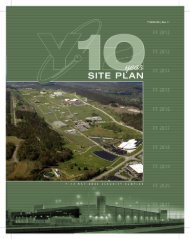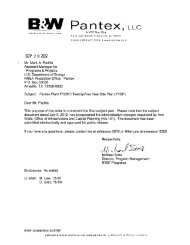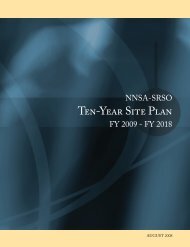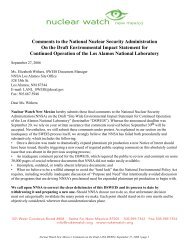NATIONAL LABORATORY PERFORMANCE MANAGEMENT PLAN ACCELERATING CLEANUP
Los Alamos National Laboratory's Performance Management Plan
Los Alamos National Laboratory's Performance Management Plan
Create successful ePaper yourself
Turn your PDF publications into a flip-book with our unique Google optimized e-Paper software.
EXECUTIVE SUMMARY<br />
This Performance Management Plan (PMP) for environmental work at the Los Alamos<br />
National Laboratory (LANL) sets forth an accelerated plan for completing the<br />
Environmental Management (EM) mission at LANL by 2015—fifteen years sooner than<br />
the current end date. It details how new approaches and changed business practices<br />
will accomplish the complete removal and disposal of legacy waste by 2010 and<br />
closeout of Environmental Restoration (ER) by 2015. It charts a forward path to the EM<br />
end-state at LANL of complete removal of legacy wastes, completion of all cleanup<br />
corrective actions, and transition to long-term environmental stewardship.<br />
Managers and staff at the US<br />
Department of Energy (DOE) and<br />
the University of California (UC)<br />
hold a strong desire to accelerate<br />
our work. We believe that the<br />
initiatives set forth in this PMP are<br />
challenging, but achievable, and<br />
will yield meaningful benefits.<br />
Accelerating EM’s completion<br />
dates will realize cost savings of<br />
approximately $950 million. The<br />
accelerated projects will reduce the<br />
highest risks that remain from<br />
historic operations, reduce<br />
programmatic risk to LANL’s<br />
ongoing stockpile stewardship<br />
mission, and help address highprofile<br />
threats such as terrorism<br />
and wildfire danger. We further<br />
believe that successful<br />
implementation of this plan will be<br />
a major accomplishment to be<br />
shared by the public, stakeholders,<br />
Background. Activities at LANL have produced<br />
byproduct wastes since the 1940s and many of the historic<br />
practices for disposing these wastes, although generally<br />
accepted at the time, are not in keeping with today’s<br />
standards. As a result, there exist numerous<br />
environmental management challenges at LANL today<br />
including<br />
• 9100 cubic meters (~25,000 packages) of transuranic<br />
waste in temporary storage and in need of final<br />
disposition;<br />
• groundwater contamination from historic discharges<br />
that includes radiological and hazardous constituents;<br />
and<br />
• hundreds of surface waste sites remaining from the<br />
more than 2100 sites spread over 43 square miles that<br />
were originally identified for cleanup, including<br />
septic tanks and lines, chemical storage areas,<br />
wastewater outfalls, landfills, incinerators, firing<br />
ranges, surface spills, and electric transformers.<br />
Much has been accomplished already; however,<br />
substantial work remains to be done, and the plans for<br />
completing waste disposition and cleanup work currently<br />
extend to 2030.<br />
regulators, Congress, and the Administration. In fact, many of these parties have<br />
expressed strong expectations that environmental work at LANL should be accelerated<br />
from the current timeline.<br />
The end-state for EM activities at LANL consists of off-site disposition of mixed and<br />
transuranic (TRU) legacy waste—including shipment of all legacy TRU waste to the<br />
Waste Isolation Pilot Plant—and completion of all EM corrective actions for<br />
groundwater and surface waste sites. All required post-remedy monitoring and<br />
maintenance will be transitioned from EM to the site landlord, the National Nuclear<br />
LANL Performance Management Plan iii July 15, 2002








